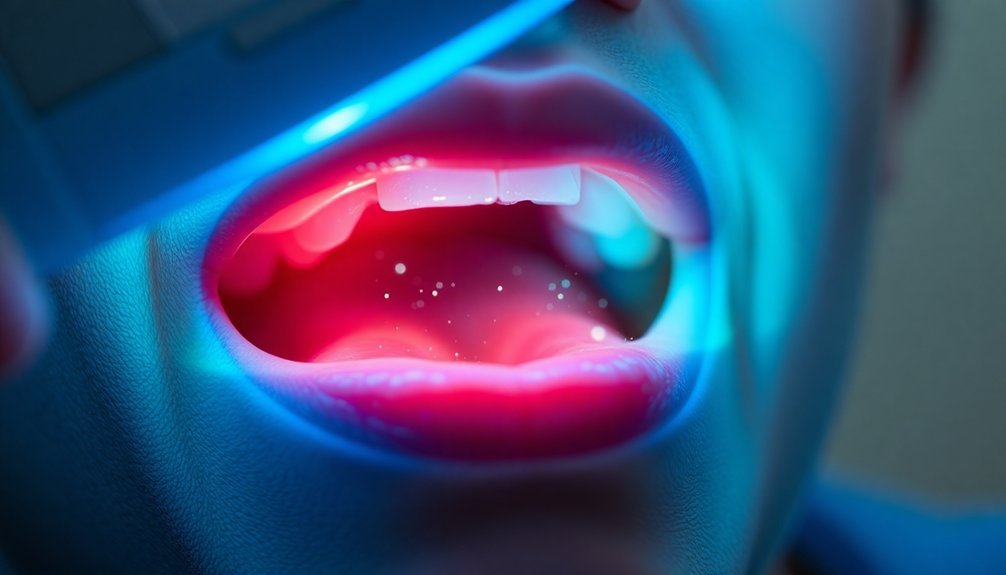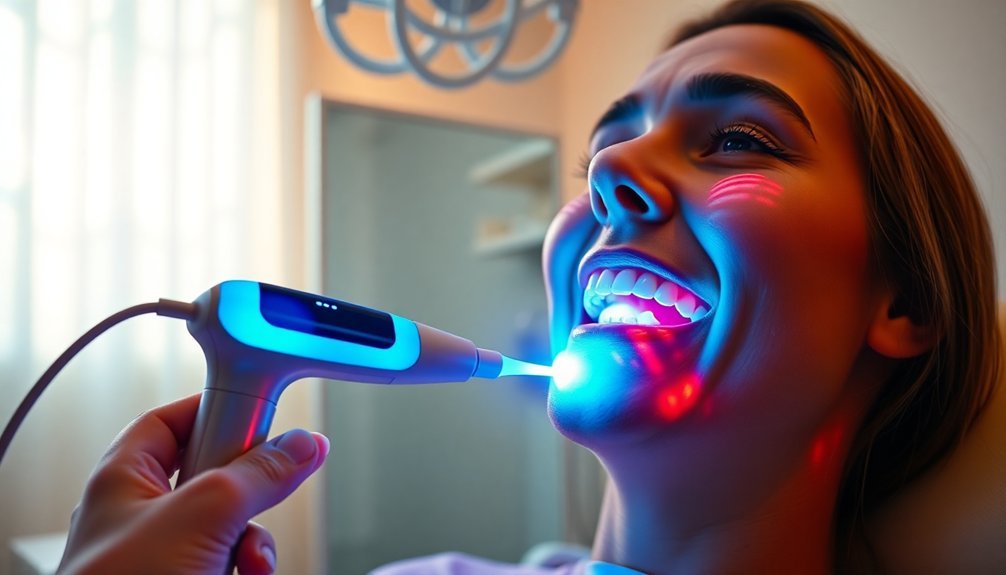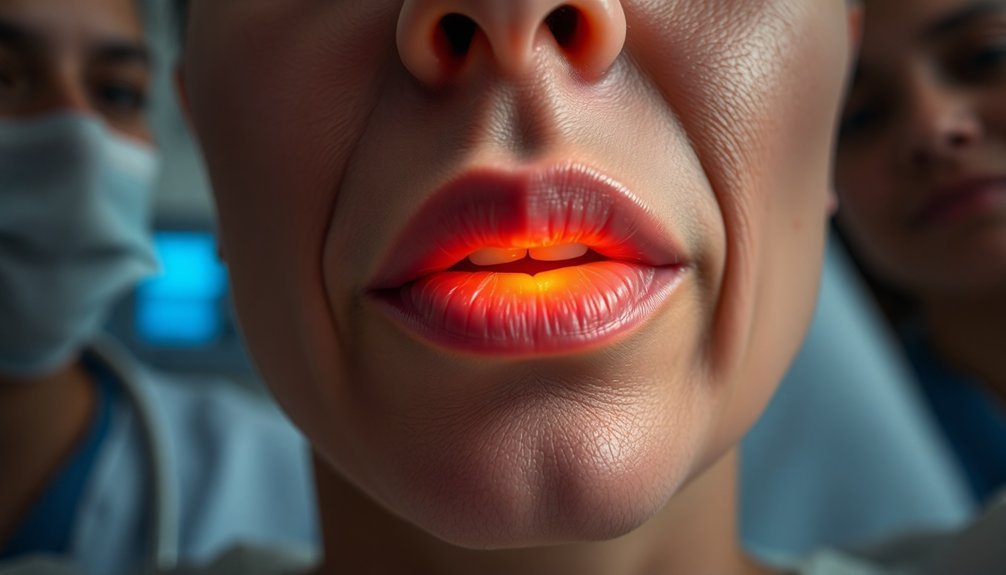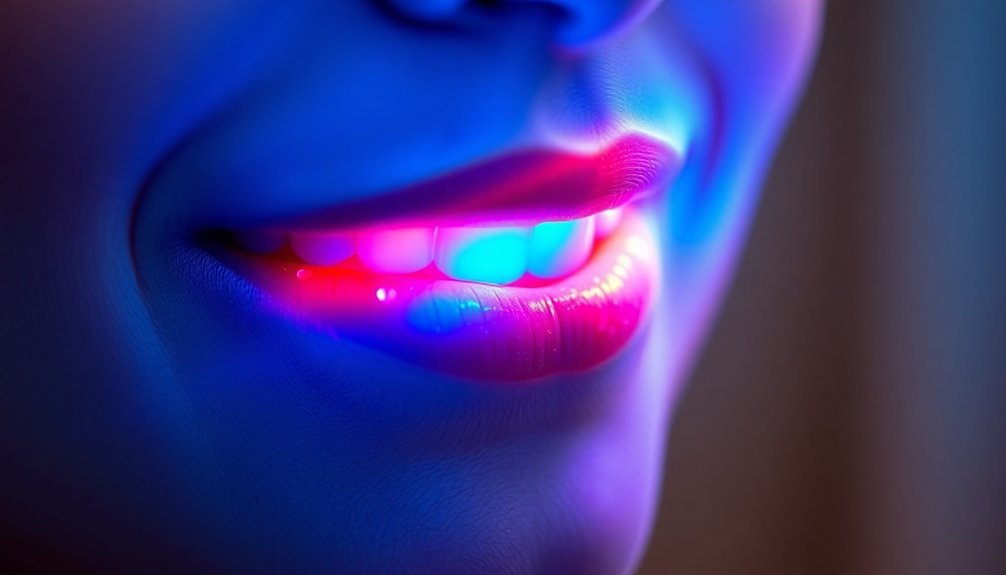Photobiomodulation (PBM) erases painful mouth sores fast by harnessing light to boost your cellular energy. When photons interact with mitochondrial components, they enhance ATP production, which accelerates tissue repair and reduces inflammation. You'll feel noticeable pain relief just a few days into treatment. PBM therapy not only promotes healing but also improves blood flow and cellular communication, making it highly effective for conditions like oral mucositis. With sessions typically lasting around ten minutes, this non-invasive approach is both safe and efficient. If you want to discover more about its benefits and applications, there's definitely more to explore.
Mechanism of Action

Photobiomodulation (PBM) operates through several key mechanisms to promote healing in mouth sores. At the heart of this process is the interaction between photons from a light source and cytochrome c oxidase (CcO) within your mitochondria. This interaction primarily occurs in the visible and near-infrared light spectrum, where CcO absorbs the photons, kickstarting a series of beneficial biological events.
As this occurs, the electron transport chain becomes more efficient, boosting ATP production. Increased ATP levels help restore your cellular metabolism, which often slows down in damaged tissues, leading to improved energy balance and enhanced tissue repair. Additionally, this increased ATP production can significantly enhance the recovery process for damaged tissues, providing quicker relief from discomfort associated with mouth sores.
This metabolic boost also plays a significant role in preventing cell death and lowering inflammation.
In tandem with ATP production, PBM promotes the photodissociation of nitric oxide (NO). This release enhances cellular signaling and promotes vasodilation, while balancing reactive oxygen species (ROS) critical for cellular function.
Together, these factors trigger signaling pathways that drive tissue repair and wound healing. With effective communication between your mitochondria and nucleus, you can expect a faster, more efficient healing process for painful mouth sores.
Clinical Effectiveness
When it comes to treating mouth sores, clinical effectiveness of photobiomodulation (PBM) therapy has shown promising results. PBM therapy markedly reduces pain intensity in conditions like oral mucositis and recurrent aphthous stomatitis. Many patients report noticeable relief within days of starting treatment.
With the use of a 980 nm laser, pain relief is particularly effective for pediatric and adolescent patients. Moreover, PBM therapy promotes faster healing rates for oral lesions, with complete resolution of ulcers observed within 21 days for some individuals. This accelerated wound healing reduces the duration of mucositis and allows patients to resume normal activities, like eating solid foods and using dental dentures. Additionally, PBM therapy has been found to effectively mitigate the adverse effects of chemotherapy on the oral mucosa, leading to improved outcomes for patients with oral mucositis as they undergo cancer treatment.
In terms of safety, PBM is non-invasive, carries minimal risk for side effects, and is safe for all patients, including children. The therapy demonstrates high patient satisfaction, thanks to reduced reliance on painkillers and improved quality of life.
Additionally, PBM shows effectiveness in managing the incidence and severity of oral mucositis in cancer patients, ensuring they can continue their treatments without severe interruptions.
Types of Photobiomodulation

When exploring types of photobiomodulation, you'll notice significant differences between laser technology and LED therapy. Lasers offer precise targeting and deep tissue benefits, while LEDs face limitations due to light spreading. Understanding these methods helps you choose the best treatment application for your needs. Laser therapy can be particularly effective for treating painful mouth sores due to its ability to penetrate deeper tissues.
Laser Technology Advantages
Laser technology offers remarkable advantages in treating mouth sores through various forms of photobiomodulation. By using low-energy light, lasers stimulate your body's natural healing processes effectively. They target mitochondria, boosting ATP production and reducing oxidative stress, which enhances cell metabolism while minimizing inflammation.
When applied in dentistry, lasers serve as a great adjunct to traditional treatments. They help relieve pain and reduce inflammation in conditions like recurrent aphthous ulcers and oral leukoplakia. With minimal swelling and discomfort, you'll find it easier to eat and maintain nutrition.
These lasers—emitting red and near-infrared light—are designed to deliver power densities ranging from 0.005W/Cm² to 5 W/Cm². Treatments usually involve small devices placed on the affected areas inside the mouth for about 10 minutes, ensuring convenience as you can undergo sessions several times a week with ease.
Protective glasses are utilized to shield your eyes during these sessions.
The benefits of laser therapy include immediate pain relief, fast wound healing, and a non-invasive approach that avoids systemic drug complications. This makes it a localized, effective solution for managing pain and promoting healthier oral tissues.
LED Efficacy Challenges
While laser technology provides effective treatment options for mouth sores, LED photobiomodulation (PBMT) presents unique challenges that can impact its efficacy. One major challenge is wavelength specificity; different wavelengths produce varying effects. Blue light (465nm) shows superior capabilities in suppressing tumor growth, while red light (629nm) might inadvertently enhance oral cancer invasiveness, raising safety concerns.
Moreover, the energy dose is critical; low doses can stimulate cellular functions, but high doses might be counterproductive. Treatment duration and frequency are important too—short sessions, like 10 minutes three times a week, prove essential for ideal outcomes.
In addition, the divergence between in vitro and in vivo study results demonstrates the need for further refinement of PBMT protocols. Wavelength, spectrum, treatment duration, and cell types all considerably influence PBMT's effectiveness.
Finally, tumor oxygenation levels also play a critical role in determining the overall effects of PBMT.
Addressing these challenges is important for fully harnessing LED PBMT's potential in treating painful mouth sores while ensuring patient safety and maximizing treatment outcomes.
Treatment Application Methods
Several treatment application methods exist for photobiomodulation (PBMT), allowing flexibility in addressing mouth sores. You can choose from contact or non-contact modes, depending on what feels best for you.
The spot technique targets specific sores, while continuous or pulsed wave modes offer different therapeutic advantages. Pulsed mode, for example, can help prevent injury and enhance wound healing.
Regarding treatment parameters, energy density typically ranges from 1 to 10 J/cm² for superficial lesions and 10-50 J/cm² for deeper issues. The wavelength used often falls between 600-950 nm, with an output power between 250 and 500 mW or sometimes lower.
You'll experience irradiation times varying from 20 to 180 seconds, with treatments usually performed two to three times per week.
Low-level laser light therapy devices, such as diode lasers and GaAlAs lasers, effectively deliver these treatments. Shaded glasses protect your eyes during sessions, and devices can be conveniently placed on your cheek, tongue, or inside your mouth.
Following a clinical protocol of seven sessions over 21 days can lead to significant pain relief and accelerated healing for your mouth sores.
Treatment Procedure
To start the treatment procedure for mouth sores, you'll first put on shaded glasses to protect your eyes from the light.
Then, a small device will be placed either on your cheek, tongue, or inside your mouth, which can be applied in contact or non-contact mode.
Each session lasts about 10 minutes and is typically performed two to three times a week for ideal results.
Device Application Process
The device application process for treating mouth sores involves several essential steps to guarantee effective photobiomodulation therapy. First, you'll need to prepare the photobiomodulation device, selecting a low-level laser or LED and setting it to the appropriate parameters, like energy density and output power. Always wear shaded glasses to protect your eyes during this process.
Next, you'll place the device on or near the affected area, whether that's the cheek, tongue, or inside the mouth. A glass tip with a flat surface allows for precise application. Make sure it's held in contact or non-contact mode, depending on the situation, ensuring the treatment area is fully irradiated.
Check the treatment settings: an energy density of 4 J/cm² is common, with an output power around 100 mW, and irradiation times of 20 to 60 seconds per point. Continuous wave or pulsed light can be used based on your treatment protocol.
Here's a quick overview:
| Step | Action | Notes |
|---|---|---|
| Device Preparation | Select device | Low-level laser or LED |
| Placement | Position on sores | Cheek, tongue, or mouth |
| Application Mode | Choose contact/non-contact | Based on treatment needs |
| Check Energy Setting | Set specific parameters | 4 J/cm², 100 mW |
| Post-Treatment Care | Monitor reactions | Report any abnormalities |
Duration and Frequency
When planning your treatment for mouth sores, it's important to contemplate both the duration of each session and the frequency of treatments. Each session typically lasts about 10 minutes, with specific exposure time per point ranging between 30 seconds and 180 seconds, depending on the protocol.
For a 980 nm laser, the irradiation time is usually set at 60 seconds per point, delivering around 1.5 Joules of energy.
As for the frequency of your sessions, most protocols recommend treatments three times a week. In some cases, you might undergo daily or alternate-day treatments for up to two weeks. For instance, the 980 nm laser could be used twice a week with a 72-hour interval between sessions.
Your overall treatment course may last around two weeks, depending on how your symptoms resolve and your healing progresses.
When dealing with oral mucositis, it's common to continue PBM until radiotherapy concludes.
To ascertain you're getting the right frequency and duration, regular follow-up assessments are essential to tailor the treatment to your individual needs and track your progress effectively.
Protective Eyewear Usage
Protective eyewear is essential during photobiomodulation (PBM) treatment to safeguard your eyes from potential harm caused by the therapy's low-energy light. It's vital to prevent any possible damage, and your healthcare provider will provide the necessary shaded glasses before your session begins.
These specialized glasses are designed specifically to block the wavelengths used in PBM therapy, ensuring complete protection for your eyes. You'll need to wear the eyewear throughout the entire treatment session, so it's important that it's fitted correctly beforehand.
Make sure to keep the glasses on until the healthcare provider tells you it's safe to remove them. Using the protective eyewear isn't just a suggestion; it's part of standard safety protocol during PBM therapy.
Without it, there could be risks to your eye health, which is why your provider will emphasize its importance. Proper use of the eyewear is essential for your safety and the overall success of the treatment.
Impact on Cancer Treatment

In recent years, photobiomodulation therapy (PBMT) has gained attention for its significant impact on cancer treatment, particularly in managing the demanding side effects of therapies like chemotherapy and radiation.
For patients dealing with oral mucositis, a common consequence of these treatments, PBMT effectively prevents and treats the pain associated with mouth sores. It also aids in reducing chemotherapy-induced peripheral neuropathy, which often diminishes quality of life.
Additionally, PBMT shows promise in addressing breast cancer-related lymphedema and radiodermatitis, further supporting patient comfort. The best part? There haven't been any significant safety issues linked to tumor stimulation or recurrence with PBMT, making it a safe addition to cancer care.
This therapy not only alleviates painful symptoms but may also replace opioids in managing these side effects, cutting down on opioid dependence.
As guidelines from organizations like the Multinational Association of Supportive Care in Cancer promote its use, PBMT is becoming an integral part of thorough cancer management, paving the way for more effective approaches to patient care.
Economic and Practical Considerations
As patients and healthcare providers seek effective solutions for managing mouth sores, economic and practical considerations around photobiomodulation therapy (PBMT) come into play.
PBMT is emerging as a cost-effective treatment option, thanks to its non-invasive nature and ability to reduce the need for other medications. The PBM market is poised for significant growth, projected to reach $455.1 million by 2031, highlighting increasing investment in this therapy.
Practically, PBMT stands out due to its short treatment duration of about 10 minutes, performed three times a week. This ease of administration makes it a convenient option, and patients experience no side effects, enhancing comfort.
Additionally, the potential for home use with handheld devices adds to its practicality.
With PBMT accelerating healing and reducing medication requirements, patients benefit from long-term savings and improved quality of life. As insurance coverage for PBM becomes more accessible, you'll find it easier to incorporate this therapy into your routine.
Frequently Asked Questions
Is Photobiomodulation Safe for All Age Groups?
Yes, photobiomodulation is generally safe for all age groups. Studies show it has low side effects, and it's well-tolerated among children, adults, and seniors, though caution is advised for specific populations like pregnant women.
How Long Does It Take to See Results?
You can start seeing results within a few days after your first treatment. Most people notice significant improvements in pain and healing within 4-7 days, enhancing comfort and making eating easier quite quickly.
Can Photobiomodulation Be Used Alongside Other Treatments?
Yes, you can use photobiomodulation alongside other treatments. It enhances healing without interfering with existing protocols, making it an effective adjunct therapy for various conditions, and often speeds up recovery from oral lesions and surgeries.
Are There Any At-Home Devices Available?
Yes, there are at-home devices for photobiomodulation therapy available, although options can be limited. You should consult a healthcare professional for guidance on selecting a device that's safe and effective for your needs.
What Should I Expect During the First Treatment Session?
During your first treatment session, you'll experience a non-painful procedure where a device emits low-energy light onto affected areas. Expect clear instructions, eye protection, and a clinical setting designed to guarantee your comfort and safety.
In Summary
To summarize, photobiomodulation offers a promising, rapid solution for painful mouth sores by utilizing specific light wavelengths to promote healing and reduce inflammation. Its clinical effectiveness and non-invasive nature make it a viable option for many patients. With various treatment types and the potential to enhance cancer treatments, this therapy stands out for both practicality and economic feasibility. If you're seeking relief from mouth sores, consider exploring photobiomodulation as a fast and effective option for your needs.





Leave a Reply